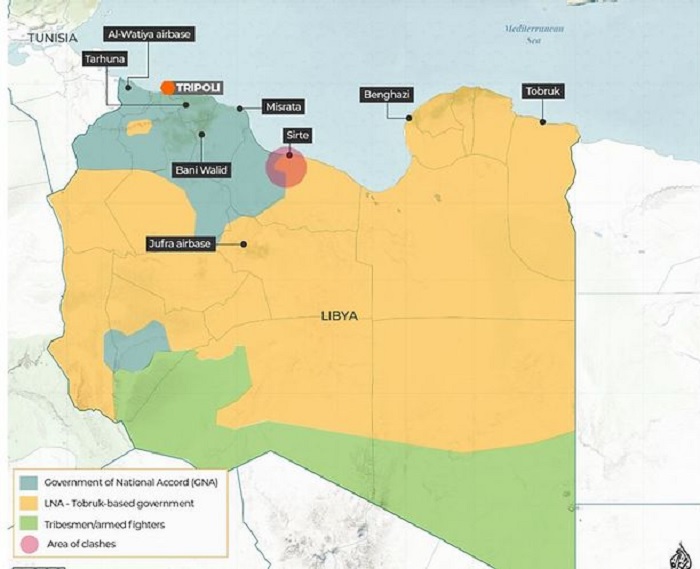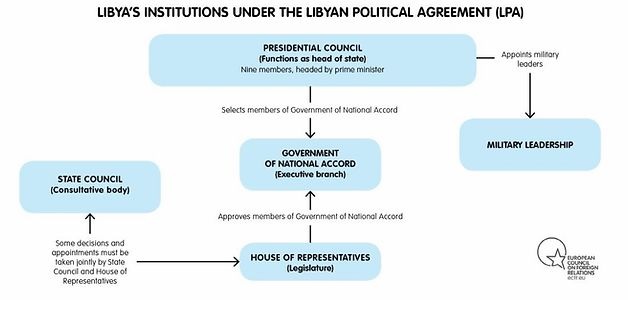The Libyan conflict erupted in the Northern African country upon the failure of Geddafie’s regime, and has never seen any symptom of recovery ever since. It all started when a massive revolution swept the Middle East and North African region calling for democracy and civil rights in 2011. The situation precipitously escalated upon the NATO military intervention in support of the demonstrators, which turned a commanding call for freedom into a bloodbath. A ten month long war in 2011 ended the Gaddafie regime along with the Libyan military artillery and capabilities, making the country vulnerable to international intervention and proxy wars. The political unrest was a major contributor to the country’s instability.

Currently there are two major players in the conflict; The Libyan National Army (LNA) and the Government of National Accord (GNA). The LNA is led by Marshal Khalifa Heftar who is based in the eastern region of Libya and is supported by France, Egypt, and Russia. On the other hand, the GNA is led by Prime Minster Faiz Alseraj , supported by militia leaders from the western city of Misratah, and backed by Turkey, Qatar, and has the official recognition of the international community. The two sides have been in direct war since April 2019 over control of the capital city of Tripoli. As of mid June, a non official ceasefire agreement was made under international pressure for a peaceful resolution to end the conflict. Outlined below is how this negotiation could be successful.
History of Conflict
The LNA emerged in Benghazi in 2014 to compact ISIS prevalence after a series of assassinations of political and civil activists, military personals, and foreigners. ISIS in Libya even claimed responsibility for the infamous assassination of U.S ambassador Christopher Stevens in Benghazi and the beheading of 21 Egyptian Copts (DENTICE, 2017, P1). After two years of a bloody war, the LNA commander Khalifa Hafter announced the complete liberation of the city of Benghazi and started preparing for a bigger campaign to rid all of Libya from “extremist militias”, a broad definition that would have severe consequences. During that time, the newly formed and internationally recognized government of national accord did nothing to support any stability efforts in Libya’s second biggest city. In fact, senior officials and militia leaders of the GNA voiced their support to militia members allied with ISIS in their fight against the LNA. Many ships leaving the port city of Misrtah were spotted by international surveillance and eyewitnesses providing ammunition and support for those militias. Within a few months of liberating Benghazi, the LNA started marching towards the Southwest of Libya, controlling many important oil fields. By April 2019, the LNA announced its attempt to capture the capital city of Tripoli, disregarding the ongoing negotiations with the GNA (Shay, 2019, P3).The GNA on the other hand, is the internationally recognized government that emerged upon the Libyan Political Agreement in 2016. The GNA control of Libyan oil revenue enabled them to create military defense by enrolling dominating military groups in Tripoli, in their payroll and subsequently legitimizing them. This backfired as war between prevailing militias in Tripoli and Misrtah had multiple episodes in 2017 and continued until the LNA attacked Tripoli. Subsequently, the LNA attacking the GNA in Tripoli actually unified the GNA against one common enemy, General Haftar. In spite of all, the GNA offers hope of a functional civilian government. On the contrary, to the military regime that LNA offers.
Essence of Conflict
The two most important financial institutions of Libya are the Libya National Oil Corporation (NOC), and the Libyan National Central Bank (NCB). Both are placed in Tripoli and under the control of the GNA. Historically, the resources of Libya’s three regions have been controlled by the western region of Tripoli. This monopoly of resources intensified during the 42 years of Gaddafi’s role. During Geddafie’s Jamheryat, power, key positions, and oil revenues were predominantly controlled by Tripoli based personals. This did not change after the 2011 revolution that sparked in the eastern city of Benghazi and this issue remains unsolved today. The southern region of Libya, Fazzan, is immensely ignored by politicians and

State funding. The role of law in the south is dominated by tribal powers that are somewhat stable. Some of whom practice smuggling of illegal goods and immigrants under the vast vacancy of state policing or border control (Shay, 2019, P3). In other words, oil and unfair distribution of oil revenues are the essence of the conflict that is fueled by international greed (Shay, 2019, P3).
Current Efforts: International Intervention
Despite the weapons embargo on Libya, many UN member countries has continued to provide ammunition and weapons in a clear “violation of UN Security Council Resolution 1970/201” (DENTICE, 2017, P1). The instability in Libya had direct consequences on western capitals as 2017’s “attack on a concert in London was linked to an ISIS cell in Libya” (Neale,2018, P2). Moreover, the instability of Libyan southern and northern borders has significantly increased the illegal migration across the Mediterranean to Europe. The regional conflicts between Turkey and Egypt over control of the Mediterranean have intensified in Libya, leading to the signing of a memorandum of understanding between the GNA and Turkey. Subsequently, Turkey was the first to send boots on the ground in support of its ally, which provoked the Egyptian president, Abdulftah AlSesi, to draw a “red line” on Sirte and Jufra on June 21st (Washington Post, ) This prevented the GNA from advancing towards the Egyptian borders and controlling more territory. This is especially important to the LNA and it’s supporters, as the majority of Libyan oil is in the “Oil Crescent”, few kilometers east of Sirte.
LNA Position
The continuous targeted assassinations of military personnel in Benghazi in 2013 and the persistent ISIS activities created a public outrage. People began demonstrating, demanding the formation of police and military protection. These events marked the birth of the Libyan National Army under Commander Hafter. The LNA was endorsed by the House of Representatives, and gathered international support from neighboring and regional countries, with strategic and political interest in Libya. The LNA recognizes that the GNA is unconstitutional, and in violation of the Libyan Political Agreement, Article 4, section 1 which states “The term of the Government of National Accord shall be one year as of the date of granting it a vote of confidence by the House of Representatives” (LPA, P6). The GNA has remained in power since 2016.
GNA Position
The Government of National accord was formed a year after signing the Libyan political agreement, and was immediately endorsed by the United Nations, and the international community. The GNA worked on combining military groups under one structural military and government. Supporters of the GNA see much resemblance of general Haftar to Colonel Geddafie, and fears another military rule in Libya. The presidential council also has the full support of Misratah City Council and neighboring cities. These entities played a crucial role in the downfall of Gaddafi, and they remain one of the most dominant military powers in the country. Many civil rights activists and democracy supporters are strictly opposed to a military based government. In response to the hegemony of militias and use of foreign armies and mercenaries to combat the military rule, many will proclaim a Machiavellian stance where the end justifies the means.
Proposed Solution
The solution proposed here is not something that has been tried in the past. In any conflict, it is recommended to map back to the time of “no conflict” and attempt to simulate an analogous situation. For Libya, this time period was during the Libyan Kingdom (1951-1969) when Libyan King Idres Al Senussi came upon the second war and unified the three states of Libya (Cyrenica, Tripoltinia, and Fazan). As a result, each state had independent civil jurisdiction under one federal government. Currently, the LNA and GNA are on a ceasefire agreement on the skirts of the center city of Sirt. This location of the city can provide a “favorable climate for negotiation” (Ury.W,1998) as this is almost exactly the center of Libya. The city can serve as a compact capital, similar to Washington D.C., where major institutions and diplomatic missions can be safely placed. However, first, the following conditions should be present:
The city should be a no-fly, demilitarized zone.
Relocating the Libyan central bank, and National Oil Corporation to the city
Provide international supervision to guarantee meeting the above conditions
Re-establish the constitution reform committee in the city with a 12 months deadline for a constitution draft
Transfer the High National Election Commission to the city
Conduct Presidential and parliamentary elections to hold office in the cityAlthough such solution can be convoluted, it can lay the ground for a strong unified government that is able to operate and function away from military intervention and political influence.government is able to operate and function away from military intervention and tribal influence.
Conclusion
In conclusion, the Libyan dilemma has many complexities and there are fundamental differences among the LNA and GNA supporters. The abominable battle of Tripoli has proven that military escalation is not the answer. Therefore, negotiation is a must. In order to negotiate, stakeholders and decision makers must be provided with the appropriate political and security environment that is impervious to foreign interference. Transferring key financial institutions away from conflict areas will spare them from being used as a political tool in any negotiation. This will give the politicians the chance to “go to the balcony” while keeping their eyes on the prize (Ury,1998). As they reframe the conflict by identifying the common goal, in this case a peaceful, united Libya.
